Climate finance is rapidly transforming the investment landscape in the U.S., as Americans increasingly direct their funds toward sustainable and eco-friendly initiatives. This shift highlights a growing awareness of the need to address climate change and the role that financial markets play in facilitating the green transition. By incorporating climate finance strategies, investors are not only seeking profitable returns, but also aiming to make a positive environmental impact.
With the green transition gaining momentum, many U.S. investors are recognizing the potential long-term benefits of integrating climate finance into their portfolios. This growing trend is supported by an array of financial instruments, such as green bonds and sustainable funds, which offer avenues for individuals to contribute to environmental solutions.
Understanding climate finance in the U.S.

In the United States, climate finance is becoming an essential component of modern investment strategies. It encompasses the array of financial tools and investments aimed at supporting projects that mitigate climate change impacts. This sector has seen significant growth as investors prioritize sustainable development. With global warming concerns at the forefront, businesses and individuals alike are adopting more responsible investment behaviors.
Federal initiatives and incentives make climate finance attractive in the U.S., ensuring capital flows towards renewable energy projects and green technologies. These initiatives not only aim to reduce carbon footprints but also encourage job creation and economic growth in burgeoning green industries. As this financial niche grows, it supports a robust ecosystem of innovation and development that aligns with sustainability goals.
Investment tools driving the green transition
Green bonds and sustainable funds lead the charge in the climate finance sector, providing crucial backing for environmentally friendly projects. Green bonds offer a way to finance initiatives like clean energy development, while sustainable funds focus on companies with strong environmental, social, and governance (ESG) practices.
The appeal of these instruments is growing as they often yield competitive returns while aligning with investor values. Recent studies indicate that ESG-focused investments can outperform traditional portfolios, attracting traditional and new investors ready to embrace the green revolution. As understanding and accessibility improve, diversification with climate finance products becomes increasingly feasible.
The role of policy in enhancing climate finance
Policies at the federal and state levels play a vital role in shaping the climate finance landscape in the U.S. Governmental support through incentives and tax benefits encourages private investments in clean energy and sustainability projects, driving more capital into green markets. Such policies also create a conducive environment for innovation, paving the way for new technologies and business models.
Among these policies, notable examples include tax credits for solar installations and subsidies for electric vehicles. These initiatives lower entry barriers, making it easier for individuals and organizations to engage in the green economy. As the policy framework strengthens, the collaboration between public and private sectors enhances the impact and reach of climate-driven investments.
The future of climate finance in America
As the momentum for climate finance grows, it is expected to play a significant role in the U.S. economic landscape, fostering sustainable development and innovation. Investors are increasingly drawn to the dual promise of environmental benefits and financial return.
In conclusion, climate finance represents a promising pathway toward a more sustainable and resilient economy in the U.S. As the sector evolves, it will provide more opportunities for investors to contribute to environmental sustainability while achieving potential financial benefits. By embracing these strategies, Americans are not only investing in a greener future but also paving the way for economic growth aligned with ecological preservation.
